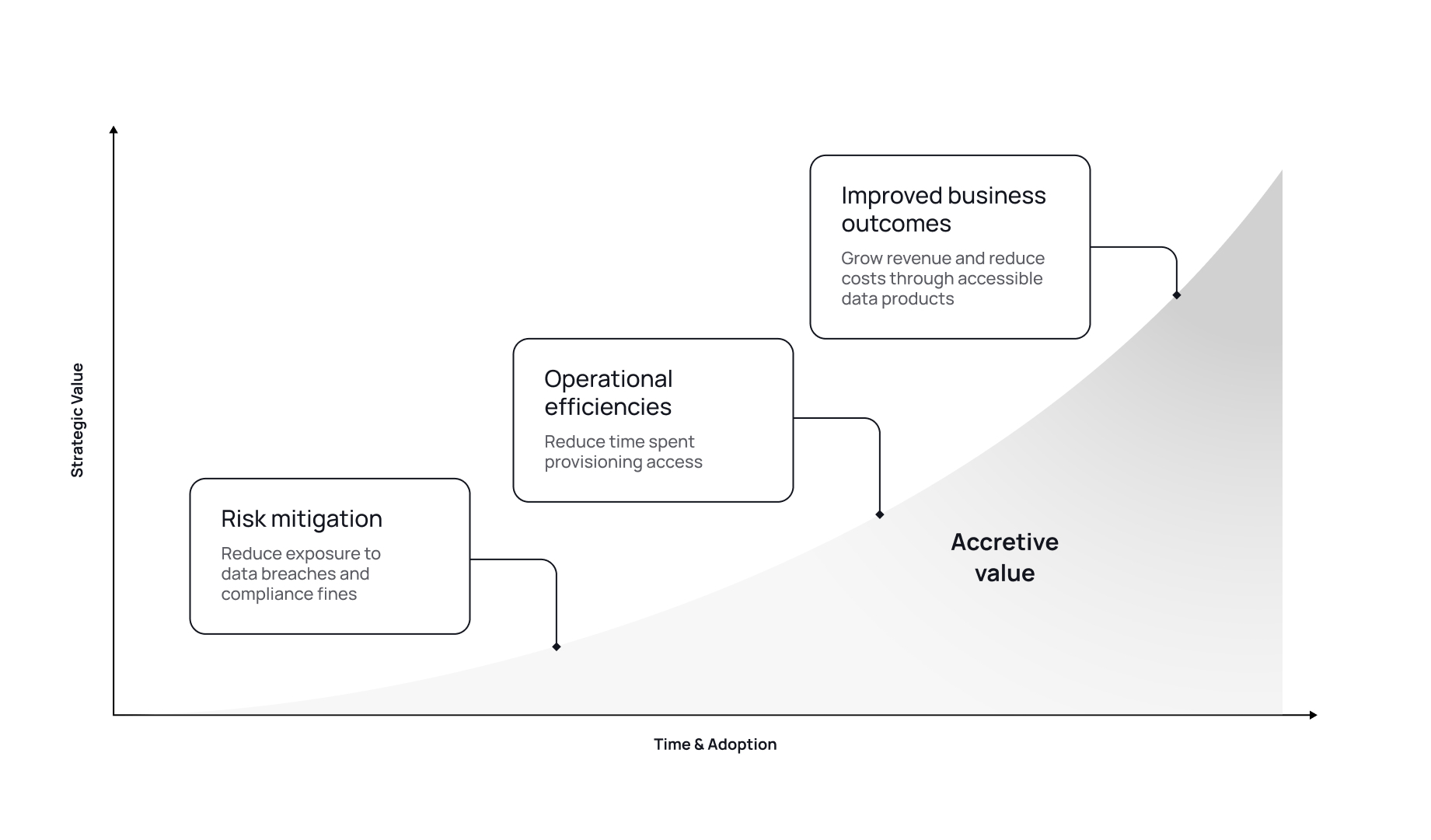The number one performance indicator for most businesses is value. How much value will this project bring us? How much value do we expect from this new hire? What value does our product provide for customers?
When investing in a new tool for your organization’s data stack, value plays just as critical of a role. No team wants to sink budget into a platform that doesn’t drive objectives and provide additional benefits to their business. And any significant platform investment must be reviewed by a range of stakeholders – including company leadership, data stewards, and security and compliance teams – before being approved
Being able to demonstrate the business value of your investment, and how it will positively impact your initiatives, is essential during this review process. At Immuta, our Value Engineering team works with data stewards to develop a structured business case that demonstrates expected value and outlines key steps for achieving it with our data security platform. In this blog, you’ll see how our business value assessment process enables customers to identify, target, and unlock value in their data stack.
Why Build a Business Case?
The justification for building a business case when investing in a data platform is twofold:
Reinforcing Data’s Value
Your organization’s data is only as good as your ability to use it. While data has intrinsic value, this value inevitably erodes if users have difficulty accessing, classifying, or securing your data resources.
Investments in data platforms are also at risk when data cannot be accessed and used securely. If these platforms – whether compute, storage, business intelligence (BI), etc. – are not being leveraged effectively, they may be seen as not meeting their objectives by anyone who isn’t working with them day-to-day. When decision-makers with control of team budgets aren’t seeing results from platforms, it’s likely they’ll be put on the chopping block.
In order to keep these platforms – and your general data platform budget – from being reduced or revoked, you need to ensure that data is consistently discoverable, accessible, and secure for business-driving use cases. This will enable you to continue to leverage data for innovation and optimization that drive business value.
Executive Alignment & Justification
When you make the case to purchase a platform like Immuta, your executive team will also need a strong business justification for this investment.According to a 2022 Gartner study, 69% of buyers require a business case to justify a new IT purchase for their organization. A business case – a concrete demonstration of how the investment will impact business objectives – is the most widely accepted method of demonstrating that your investment will satisfy these criteria and provide value.
So, while you may have a personal understanding of how Immuta’s unique functionality would be valuable to your data team, an executive may have other investments competing for that same budget. It ultimately comes down to which investment is most likely to drive tangible business outcomes.
Before approving budget for an IT investment like Immuta, executive decision makers will want to see how the platform:
- Will provide a positive financial return
- Is aligned with key strategic outcomes
- Has consensus among key stakeholders
Building a Business Case with Immuta
The process of creating a business case is often more important than the actual numbers involved – a sharply focused business outcome story will advance your proposal further than any spreadsheet could.
This is why we involve customers in the process by enabling them with the tools to build their own business cases. Working together to build the business case with your organization’s stakeholders allows you to get agreement on the problem you’re trying to solve, identify and highlight any existing value gaps, and quantify how to address these challenges and gaps.
When evaluating our platform with you, we typically follow a three-step process to create a defensible business case:
Step 1: Identify Your Executives’ Strategic Priorities
Stand in your executives’ shoes: What are their strategic priorities? How does your data enable them? What are the challenges to those priorities?
It’s important to think in terms of business transformation, and how this investment will help to drive these transformative goals. Ultimately, you need to put the bottom line up front for your executives.
We use these questions to get started:
- What are your company’s strategic priorities for the next three years?
- Example answer: We want to expand beyond North America to capture more market share and grow our revenue by 15%.
- What business outcomes do you want to achieve using your data?
- Example answer: We need our business analysts to responsibly use customer data and analyze our revenue performance in these new markets, providing our decision makers with critical insights.
- What functional obstacles do you currently face in implementing these strategic priorities?
- Example answer: Our business analysts currently wait days or weeks to access the data they need to generate revenue insights. To be successful, we want to reduce this idle time by 30%.
Discussions with leadership, and reviewing your company’s investor presentations, all-hands meetings, and earnings calls, will provide insight into the C-suite’s priorities for the year. With these strategic insights, you can start building your business value narrative from the top down. The numbers will factor in later, so keep in mind any important KPIs and metrics that would prove the success of your Immuta project for these leading stakeholders.
Step 2: Build a Business Value Assessment (BVA)
Once you’ve identified the strategic objectives that your executive sponsor is personally
responsible for, it’s time to build a business case that your sponsor will personally champion. We call this a Business Value Assessment (BVA).
A BVA serves multiple purposes: It communicates the value you anticipate deriving from Immuta; acts as a guide to measure the value you realize throughout the Immuta lifecycle; and captures both the quantified and non-quantified elements of Immuta’s value, specific to your business.
Generally, a BVA consists of three key elements:
- A short “value-for-the-business” context
- A basic description of each key value category and its associated drivers (no more than 4-5)
- Defensible estimates of costs and benefits using available data, validated by the relevant stakeholders
The Immuta Value Engineering team has tools to help any team measure its potential value with our platform. We collaborate with these teams to establish standard templates, baseline metrics, and additional resources to construct the financial portion of their business case. If your company uses its own value framework for project evaluation, it helps guide your business value assessment to appropriately capture your industry’s unique priorities.
If you don’t have an internal framework, or would like to compare your internal value framework with ours, it is as follows:

Immuta customers generally classify their estimated value into three strategic categories:
- Risk Mitigation: Reducing exposure to data breaches and compliance fines
- Operational Efficiencies: Reducing time spent provisioning or waiting for data access
- Improved Business Outcomes: Growing revenue and reducing costs through more accessible data products
Each of these categories has individual value drivers associated with them. They illustrate key metrics that Immuta improves, and help you calculate the financial benefit for executives.
Each calculated benefit should generally align to the “METRIC” format:
- M: Measurable
- E: Everyday Language
- T: Tells a Story
- R: Results
- I: Impacts P&L or Balance Sheet
- C: Champion Supported
As you build out your business value assessment, make sure you’re highlighting the areas that executive leadership cares about. Detailing use cases with Immuta that impact revenue or help manage risk is more compelling than simply listing off features and functions.
It’s also important that you clearly articulate your value story. Test whether your business case will effectively persuade an executive audience by answering questions like:
- Does your business case minimize technical jargon?
- Can you confidently summarize your business case onto one page?
- Do you have an elevator pitch that connects your business problem to your Immuta solution? (i.e. can you describe Immuta’s value to your audience in <30 seconds?)
Step 3: Share with Stakeholders, Finalize, and Deliver
Now that you have your business value assessment, and you’ve refined it with the Immuta Value Engineering team, you know that you’ve captured any and all relevant value. The next step is to share this BVA with your data team and solicit feedback. As the use case experts, they’ll help validate your key assumptions around factors like:
- Efficiency savings
- Hard cost savings
- Resource reallocation (i.e. where do you reinvest your time saved?)
- Current state vs. future state (i.e. what changes with more accessible data?)
Your organization’s data users, who will benefit most from Immuta, should have the most input during this phase. By incorporating their knowledge of your data, and what changes will occur with Immuta, you can compose a more informed and grounded business case that stands up to any scrutiny.
Successful business case presentations depend on how well you account for concerns raised by your organization’s leadership. Therefore, in advance of the presentation, socialize the business case with key stakeholders and assess where you stand. This will give you an opportunity to make changes as needed and for your decision-makers to better prepare for the committee conversation. Based on your discussion, you and your team may want to solicit further feedback or reshape your narrative.
Sometimes, emerging business priorities like hiring freezes, mergers, reorgs, or a pending IPO may threaten to slow the internal momentum you’ve built for the investment. Instead of delaying, adapt your pitch to illustrate how an investment serves these new priorities.
Final Thoughts
The process of creating and communicating a strong business case for the Immuta Data Security Platform won’t just help secure stakeholder buy-in — it also ensures that the capabilities you implement will support your organization’s strategic business objectives.
Additionally, a good business case enables you with clear performance targets to achieve and measure as you fully unlock your data’s value.
Our Value Engineering team works with evaluators and customers to measure trends, capture relevant value stories, and promulgate best practices for estimating Immuta’s value in a credible, compelling way. We’re here to help you, so contact us to learn more about what we can do. To get in touch with our team, request a demo.



